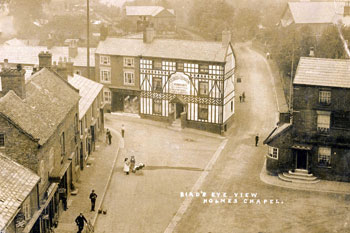Population and Household Surveys: Census and Electoral Registers
 Census records 1841 to 1921
Census records 1841 to 1921
National censuses have been taken every ten years from since 1801. The 1841 census was the first to include addresses, names, occupations, birthplaces and ages (often rounded down to the nearest five years for people over 15).
From 1851 onwards a person’s exact age and parish of birth were supposed to be recorded (although in practice these were not always given accurately). The 1851 census was also the first to indicate the relationship of each person listed to the head of the household. Census information was collected geographically by address, and everyone who slept in a house on the census night should be listed – it may not have been their usual home.
Census surveys took place on Sundays on:
- 6 June 1841
- 30 March 1851
- 7 April 1861
- 2 April 1871
- 3 April 1881
- 5 April 1891
- 31 March 1901
- 2 April 1911
- 19 June 1921
These records allow you to place individuals in family groups and observe the progress of the family over time.
Census records remain confidential for up to 100 years. The 1921 census is the most recent to be made available. The 1911 and 1921 censuses are the only ones where the original forms completed by the heads of household have survived.
All of the censuses can be searched and viewed online. Find My Past and Ancestry both have searchable transcripts and images for all the censuses from 1841 to 1911, but the 1921 census is exclusively available on Find My Past, and requires a personal subscription for access.
Tip– Use the age and place of birth details on census forms to help find individuals in birth registration indexes and parish registers.
Annual Electoral Registers
1832 to present
Electoral registers record the names and addresses of people entitled to vote at elections. They were introduced in 1832, when only around 1 in 7 men were eligible to vote, depending upon the value of the property they owned. This qualification was gradually extended so that by 1884 around two-thirds of men over 21 appear in the electoral registers. Most women over the age of 30 gained the right to vote in1918, and only in 1928 did all adults over 21 gain the right to vote. The qualifying age was reduced to 18 in 1969.
The electoral registers were arranged by constituency and polling district, with households in towns and cities usually listed by street and house numbers, while voters in rural areas appeared in alphabetical order by surname. The qualifying date for appearing in the electoral register was several months before the published date of the register.
No registers were compiled during the wartime years of 1916-1917 and 1940-1944. Registers complied immediately after both wars included ‘absent voters’ lists to allow serving military personnel to vote in their home constituencies. In 1918 and 1919 these included military service numbers, rank and regiments.
Some of our constituency collections are incomplete, including Birkenhead, Stockport and Wallasey but may be held elsewhere. Check what we hold using CCRg as Reference in our online catalogue advanced search.
Useful Links
Tip– To find out when a person or family arrived at or left an address, start by checking at five-yearly intervals, and then narrow it down.